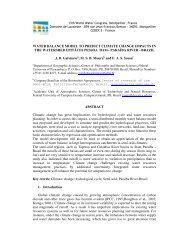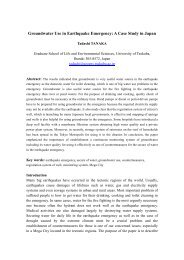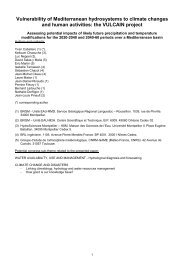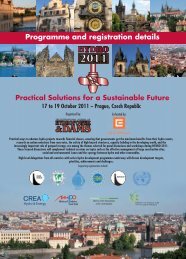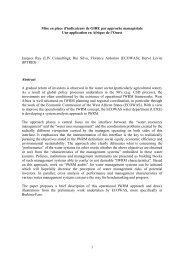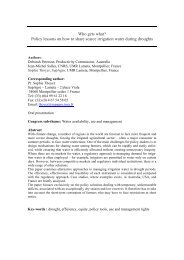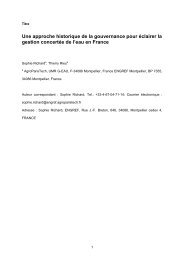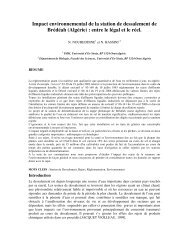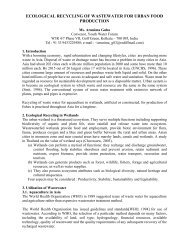HYDRAULIC MODEL OF TRICKLE-IRRIGATION LATERALS - IWRA
HYDRAULIC MODEL OF TRICKLE-IRRIGATION LATERALS - IWRA
HYDRAULIC MODEL OF TRICKLE-IRRIGATION LATERALS - IWRA
You also want an ePaper? Increase the reach of your titles
YUMPU automatically turns print PDFs into web optimized ePapers that Google loves.
7. Analysis of the obtained results.<br />
The deviation of hydraulic head along the lateral length is in the limits of 9%,<br />
h0<br />
− hmin<br />
calculated according to the formula , where h 0<br />
is the hydraulic head at the<br />
h<br />
0<br />
lateral beginning, hmin<br />
is the minimum hydraulic head for the whole lateral length.<br />
The deviation of emitters discharge is in the limits of 5%, calculated according to<br />
q0<br />
− qmin<br />
the formula , where q 0<br />
is the emitter discharge at the lateral beginning, and<br />
q<br />
0<br />
q min<br />
is the minimum emitter discharge for the whole lateral length.<br />
The total head loss for l = 10m<br />
are 0,015m<br />
, and for l = 50m<br />
are 0 ,002m . The<br />
diagrams of exponents n, m , the one of coefficient K<br />
0<br />
, reading temperature influence<br />
on the kinematic viscosity and the coefficient of Boussinesq report that flow regime turns<br />
from turbulent to laminar at l = 60m .<br />
The “potential” emission uniformity of the drippers “Typhoon 16250”, calculated<br />
for the model data with local head loss reading by means of the Benami and Offen<br />
coefficient is calculated according to the formula (Keller и Karmeli (1974)):<br />
⎛ C ⎞<br />
V<br />
qmin<br />
EU = 100⎜1,0<br />
−1,27<br />
⎟<br />
(3.5.1.1)<br />
⎜ N ⎟ q<br />
p a<br />
⎝<br />
⎠<br />
where: EU is the emission uniformity, %; C is the coefficient of the manufacturer<br />
variability; N is the drippers number per plant; q is the minimum emitter discharge<br />
p<br />
along the lateral length; is the average emitter discharge along the lateral length .<br />
q a<br />
The “potential” emission uniformity for C<br />
V<br />
= 3%<br />
, N<br />
p<br />
= 8 , q = 1,665<br />
min<br />
l / h ,<br />
q a<br />
= 1,68261 is EU teor<br />
= 97,6%<br />
. The “real” emission uniformity for the experimental<br />
data q = 1, min<br />
55 , q a<br />
= 1,7239 is EU exp<br />
= 89%<br />
. The “real” emission uniformity is always<br />
less than “ the potential” emission uniformity .<br />
Burt и Styles (1994) point out, that the “potential” emission uniformity varies<br />
about 90%, and the “real” emission uniformity for California is about 70%.<br />
V<br />
min<br />
8. Conclusions<br />
A model for hydraulic design of a drip lateral on the basis of theory of spatially<br />
varied flow is derived in this paper<br />
The developed model and the program in SIMULINK-MATLAB give an<br />
opportunity for more accurate hydraulic design of trickle laterals. The model is<br />
theoretically based and the program is open for substituting with different lateral<br />
parameters. It is estimated in this paper that the deviation of hydraulic head along the<br />
lateral length is in the limits of 9%, that is within the limits of the allowable pressure and<br />
discharge variations. It was established in this paper that the deviation of emitters<br />
discharge is in the limits of 5%. For inline emitters it could be recommended δ = 0, 1. For<br />
online emitters averaged values for δ = 0, 5 and α = 1, 05 could be assumedm for<br />
10



